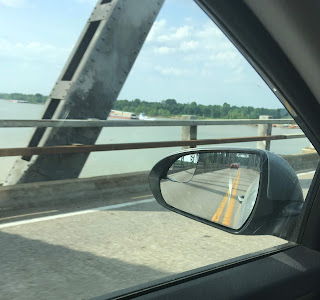We woke up early on Labor Day 2018. The Dwight D. Eisenhower Library and Museum opened at 9:00 AM in Abilene, and we wanted to be somewhat close to there by then.
I remember my first visit to the Eisenhower Library. I was pretty young. The only thing I knew about Abilene was from the cowboy movies and from Gunsmoke about being a rowdy cowboy town. Back during that first visit, that was what I was half-expecting. But Abilene was not. Pretty slow town. I remember the chapel where Eisenhower was buried and his boyhood home. But I mostly remember on that visit long, long ago was visiting prairie dog town -- a large expanse of gopher rodents coming out of the ground.
Fast forward to 2018. While my family made several stops to the Eisenhower Library over the years, we only did the free stuff. The chapel, the house, walking around the grounds, browsing the stuff at the gift shop. This time was different. We were actually going to pay admission to visit the Museum and get it counted on the presidential library passport.
But, alas as we got to Abilene and to the Eisenhower Center, the Museum was closed for repairs! All of the exhibits were moved to the Library. Most Presidential Libraries are off limits except for authorized researchers, but this time, the staff was allowing anyone to visit the Library as part of the Museum exhibit.
 |
| Library entrance |
One thing I didn't know. Eisenhower signed the law to create NASA. This led to JFK being able to promise to land a man on the moon.
Outside on the grounds is the Peace Monument. It is General Eisenhower statue surrounded by a large peace medallion. Peace was very important to President Eisenhower. Here is a picture of the statue and me casting shadows on the dove symbol.
After finishing up at the Eisenhower Center, we drove east, leaving the state of Kansas at the Kansas City, Missouri city limits, as we drove to the Truman Presidential Library. This was a five-minute stop to get the passport stamped verifying our last visit in July 2015.
Leaving the Truman Library, we decided to head north, not east from the KC area. A few miles north of Worlds of Fun, we turned onto US 36, a four-lane highway all the way to Interstate 72, headed to Springfield, Illinois for the night. Since I wasn't driving, I reminisced about US 36. US 36 runs all the way Denver. It goes through the town where I went to high school, where I dragged main on Friday nights. So, US 36 played a big part in my life - going to events in Phillipsburg, Norton, Mankato, Belleville. The way to Concordia. All the towns in my high school year. And when I was a junior in college, I drove all night and most of the next day using East US 36 until I had to get on the Interstate. The same route we were on now in Missouri.
We got to Springfield, Illinois, the state capital a little after 7:00. We were surprised at how rural it was almost up to the city limits. And how quiet the city was. I had reserved a hotel several weeks before the trip that was the closest to the Amtrak station. My daughter would be taking Amtrak back to her home. I didn't realize how close the state capitol building was to the hotel. Here's a view from the front door of the hotel.
 |
| Illinois State Capitol from hotel front door |
After dinner, we took a walk around the Capitol and took several pictures. Here is one of those pictures.
A beautiful building! We had to get up early the next morning - one of us had to catch a train, and another had a seven-hour solo drive back home to Chattanooga. Part four will be the last part of this series - the long solo drive home.



































